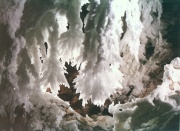Gypsum (Inventory)/Chandelier
From LagWiki
(→References) |
(Added gallery and new main image) |
||
| Line 1: | Line 1: | ||
| - | {{Inventory image|File: | + | {{Inventory image|File:Chandelier Ballroom 1.jpg|Gypsum chandelier}} |
The '''Chandelier''' field should be used to record stations that exhibit [[Gypsum (Inventory)|gypsum]] chandeliers. | The '''Chandelier''' field should be used to record stations that exhibit [[Gypsum (Inventory)|gypsum]] chandeliers. | ||
Chandeliers are easily the most impressive of gypsum formations. They hang downward from the ceiling or outward from the wall in cascading, branching arrays of white gypsum. The arms may branch in various directions but tend downward. The arms are usually more massive at the base and thin as each branch occurs often terminating in [[Gypsum (Inventory)/Needle|selenite needles]]. If still active, drops of water may be visible at the tips. If inactive, it may be coated with a fine, white gypsum powder. The arms are often described as being claw-like or dagger-like. Chandeliers can vary in size and can be quite large. Large [[Sulfates (Inventory)/Epsomite/Mirabilite|epsomite]] formations can sometimes be confused with gypsum chandeliers. | Chandeliers are easily the most impressive of gypsum formations. They hang downward from the ceiling or outward from the wall in cascading, branching arrays of white gypsum. The arms may branch in various directions but tend downward. The arms are usually more massive at the base and thin as each branch occurs often terminating in [[Gypsum (Inventory)/Needle|selenite needles]]. If still active, drops of water may be visible at the tips. If inactive, it may be coated with a fine, white gypsum powder. The arms are often described as being claw-like or dagger-like. Chandeliers can vary in size and can be quite large. Large [[Sulfates (Inventory)/Epsomite/Mirabilite|epsomite]] formations can sometimes be confused with gypsum chandeliers. | ||
| + | |||
| + | <gallery caption=Gallery perrow=1 widths=300px heights=200px> | ||
| + | File:GypsumChandelier.jpg|Gypsum chancelier | ||
| + | </gallery> | ||
==References== | ==References== | ||
| Line 8: | Line 12: | ||
{{Cave inventory}} | {{Cave inventory}} | ||
| - | |||
| - | |||
Revision as of 21:23, 26 February 2012
The Chandelier field should be used to record stations that exhibit gypsum chandeliers.
Chandeliers are easily the most impressive of gypsum formations. They hang downward from the ceiling or outward from the wall in cascading, branching arrays of white gypsum. The arms may branch in various directions but tend downward. The arms are usually more massive at the base and thin as each branch occurs often terminating in selenite needles. If still active, drops of water may be visible at the tips. If inactive, it may be coated with a fine, white gypsum powder. The arms are often described as being claw-like or dagger-like. Chandeliers can vary in size and can be quite large. Large epsomite formations can sometimes be confused with gypsum chandeliers.
References
- Palmer, Arthur N. (2007) Cave Geology CAVE BOOKS, Dayton, OH pp 291-292 ISBN-13: 978-0-939748-66-2, ISBN-10: 0-939748-66-5


